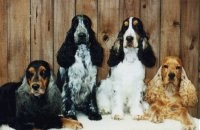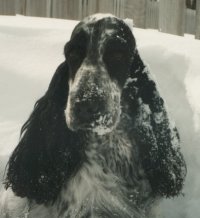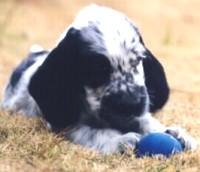|
Solid (or self) colors include black, red and liver. The red can vary in
depth of color from a light sandy gold to a deep almost Irish setter
red.
Black and liver can both have tan "points" (eyebrows, muzzle, front of legs,
on all four feet and beneath the tail). These are called 'black and tan' and
'liver and tan.'
|

Burica
|
|

Roth
|
Parti (multi) color English cockers come in a kaleidoscope of colors, the
most common of which is blue roan. If you have a hard time picturing what
"roan" means, imagine a spoonful of cinnamon and sugar mixed together (very
close to the color of an 'orange roan' English cocker) or salt and pepper
(very close to the 'blue roan' coloring).
|
|
You may also hear someone say that a particular dog has "heavy ticking." No,
they don't mean he's a time bomb or a clock ticking off the minutes, nor do
they mean he's "ticked off" about something :-) Ticking in English cockers
refers to the tiny speckles or freckles that appear on many open marked
(lots of white showing amidst larger patches of color) dogs.
Parti colors come either open marked, ticked, or roaned with white appearing
in a lovely combination with any of the solid colors mentioned above: red,
black or liver. It's very confusing, but in solid colors, the "red" is
called just that. Red. If it's combined with white, it's called "orange" or
"lemon" depending upon the depth of the red shade. Red roan is an AKC
accepted color, but few dogs are registered as such. It becomes a breeder's
option to decide as to what color their dog will be registered: orange roan,
lemon roan or red roan. They're all very much alike, the main difference
being the color of pigmentation around the eyes and nose. . .in a lemon roan
the pigment is liver instead of black. In orange roan and red roan, the
pigment stays very dark and black.
There is no standard or preferred marking for parti color English
Cockers
which allows for a wide range of unique appearances.
|
|
Our standard only
suggests that body markings be broken and distributed somewhat evenly with
white, and also states that absence of markings is acceptable as well. Some
markings can unfortunately make the difference between a "pet" and a "show
dog" to some breeders, which is indeed the prospective pet owners good
fortune.
|

'Jiggs' - Land
|